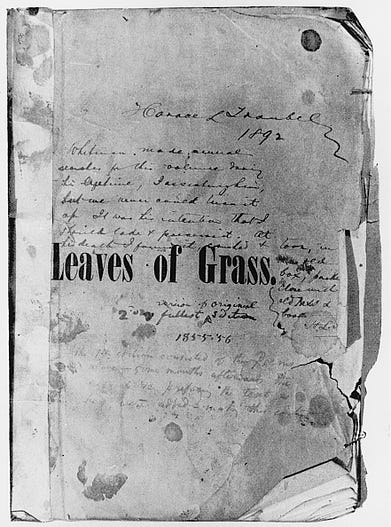|
 |
The Writer's Almanac from Thursday, July 4, 2013
"To a Young Girl in Washington Square Park" by George Green, from Lord Byron's Foot. © St. Augustine's Press, 2012.
ORIGINAL TEXT AND AUDIO - 2013
Today is Independence Day, celebrating the day in 1776 that the Second Continental Congress unanimously adopted the Declaration of Independence, and the United States officially broke from the rule of England.
On this day in 1855, Walt Whitman published the first edition of Leaves of Grass. The first edition consisted of 12 poems, and was published anonymously; Whitman set much of the type himself, and paid for its printing. Over his lifetime, he published eight more editions, adding poems each time; there were 122 new poems in the third edition alone (1860-61), and the final "death-bed edition," published in 1891, contained almost 400 poems. The first edition received several glowing — and anonymous — reviews in New York newspapers. Most of them were written by Whitman himself. The praise was unstinting: "An American bard at last!" One legitimate mention by popular columnist Fanny Fern called the collection daring and fresh. Emerson felt it was "the most extraordinary piece of wit and wisdom America has yet contributed." This wasn't a universal opinion, however; many called it filth, and poet John Greenleaf Whittier threw his copy into the fire.
The 1855 edition contained a preface, which was left out of subsequent editions, and in it he wrote: "This is what you shall do: Love the earth and sun and the animals, despise riches, give alms to every one that asks, stand up for the stupid and crazy, devote your income and labor to others, hate tyrants, argue not concerning God, have patience and indulgence toward the people, take off your hat to nothing known or unknown or to any man or number of men, go freely with powerful uneducated persons and with the young and with the mothers of families, read these leaves in the open air every season of every year of your life, re-examine all you have been told at school or church or in any book, dismiss whatever insults your own soul; and your very flesh shall be a great poem and have the richest fluency not only in its words but in the silent lines of its lips and face and between the lashes of your eyes and in every motion and joint of your body."
On this day in 1931, James Joyce (books by this author) married Nora Barnacle at the Kensington Registry Office in London. They had been living together for 26 years.
It's the birthday of Nathaniel Hawthorne, born in Salem, Massachusetts (1804). He's the author of The Scarlet Letter (1850) and The House of the Seven Gables (1851). He was looking for a job, and at last won a well-paid appointment at the Salem Custom House, only to lose it when the Whigs came into power again. He arrived home, told his wife he was out of work, and wondered aloud what to do. "Now you can write your book," she said. He asked what she proposed they live on while he wrote, and she opened a desk drawer and showed him a pile of gold pieces she'd saved out of the household allowance — $150, enough to cover their expenses for several months. He sat down at once and began work on The Scarlet Letter.
It's the birthday of literary critic Lionel Trilling, born in New York City (1905). He was one of the last literary critics that people read even if they weren't English majors. He's best known for a collection of essays published after his death, called The Moral Obligation to Be Intelligent (2000).
Be well, do good work, and keep in touch.®
If you are a paid subscriber to The Writer's Almanac with Garrison Keillor, thank you! Your financial support is used to maintain these newsletters, websites, and archive. If you’re not yet a paid subscriber and would like to become one, support can be made through our garrisonkeillor.com store, by check to Prairie Home Productions, P.O. Box 2090, Minneapolis, MN 55402, or by clicking the SUBSCRIBE button. This financial support is not tax deductible.


